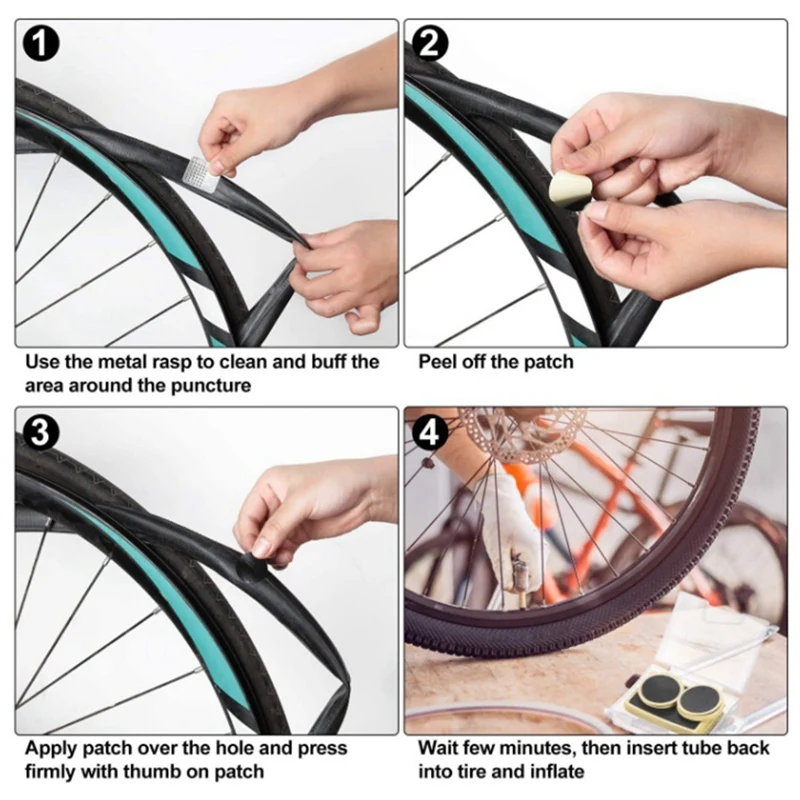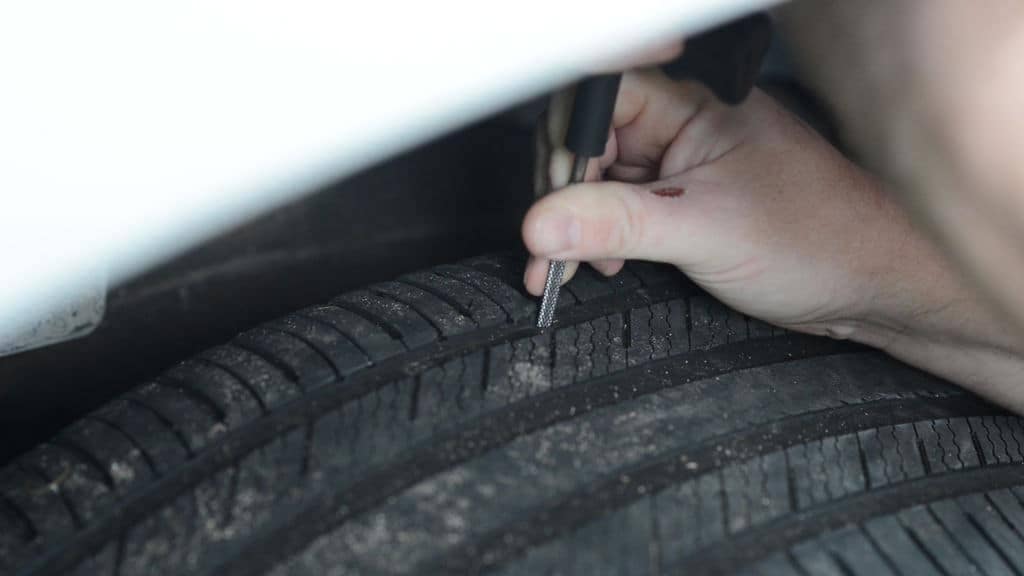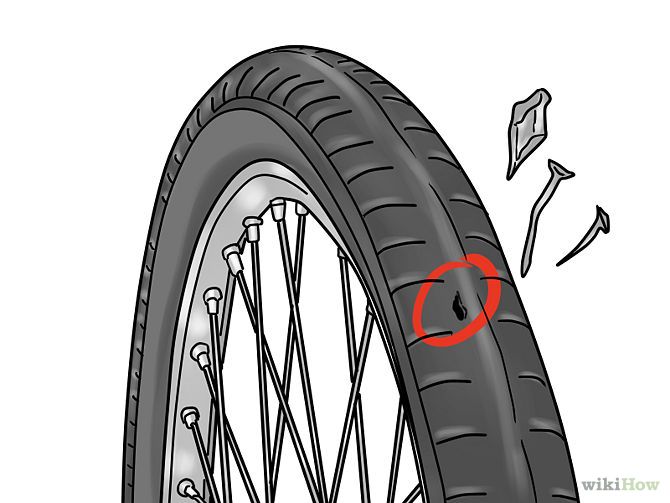By Admin
Posted in Uncategorized
Flat tires can happen at any time and can make you feel helpless. But if you are armed with some information and quick fixes, you should be back on the road quickly.
If you notice that your tire is flat but still has some air in it, you might be able to fix it with a tire patch as long as the hole is not in the sidewall. You should never drive on a tire that is more than ten pounds low on air. If the leak allows the rest of the air out, you could end up driving on the rim, which will cause damage. So what should you do when it seems like your tire is low?
Jack the vehicle up using the jack points closest to the tire. Slowly rotate the tire to find the problem. If you don’t see an object sticking out of the tire or a hole, there’s a trick to discovering the leak. Make a mixture of liquid soap and water.
As you brush the water on the tire, the mixture will create bubbles where the hole is located. If you mark the hole with chalk or white shoe polish you can easily find it again.
If the hole was caused by a nail or screw and is small, you can plug the tire, but larger holes will need to be patched. A tire plug kit contains two T handles: One has a point and a rough shaft and the other has an “eye” at the end of it.
Air the tire up to about five pounds over the recommended pressure. Next, thread a plug through the eye on the smooth-shafted T handle. Insert the T handle without the eye into the hole in the tire. Push it in and pull it out three or four times. Remove the T handle and then push the plug-loaded T handle into the hole in the tire so that the plug is all the way inside the tire. Pull the T handle out. The plug will stay in the tire and will be visible.
While you can patch a tire yourself, it may be better to bring your car to a tire shop. You must first remove the tire to install the tire patch and then remove the tire from the rim. While it’s possible to do this yourself, it can get pretty complicated.
You must first remove the tire to install the tire patch and then remove the tire from the rim. While it’s possible to do this yourself, it can get pretty complicated.
If the hole is too big to plug, you shouldn’t try to drive. A hole that’s big enough for a patch will leak quickly. The easiest and best thing to do to avoid damaging your rim is bring the tire to a tire repair center.
If you must drive the vehicle, remove the damaged tire and wheel, and install the spare. If you have another mode of transportation, remove the tire and wheel, and bring it to a tire repair center so it can be repaired safely.
You can drive for many miles on a plug or patch, however, if you notice another leak it may be time to head to a service center. If you need a second tire patch, the tire is ready to be replaced.
Safety is always the number one priority. A tire patch can help with a small leak, but if more than one is needed, it’s time for a replacement.
Every editorial product is independently selected, though we may be compensated or receive an affiliate commission if you buy something through our links. Ratings and prices are accurate and items are in stock as of time of publication.
Modern vehicle tires are tough, standing up well to rough terrain and thousands of miles of driving. Trouble is, tires are not invincible. Every so often car tires spring leaks. Air can start leaking from anywhere on a tire, and the location of the leak determines whether or not you can fix it yourself. And if you can't fix it yourself, the location of the leak will also tell you if you need a professional repair or a new tire.
Whether or not your tire is tubed or tubeless affects things, too, because only tubeless tires can be repaired using the technique of plugging that we'll show you here. The good news is that modern vehicles always have tubeless tires, and this means that repairing with a rubber plug is often an option.
The good news is that modern vehicles always have tubeless tires, and this means that repairing with a rubber plug is often an option.
Plugging a tubeless tire is only a possibility when your puncture is in the tread area. If the air leak is where the sidewall of the tire meets the rim — this is called a "bead leak" — you'll need to visit a mechanic with a tire machine to dismount the tire from the rim and remount it with sealing liquid applied to the bead. If your sidewall has been punctured, you need a new tire, because damage there can lead to a blowout at highway speeds, even after repair.
Learn exactly how to plug a tire so next time you spring a leak between your treads, you'll be able to get up and running again in record time.
Total time completing the repair is about 15 minutes. Doing the work yourself will save you about $20 and the time spent driving to the garage and waiting.

Steve Maxwell for Family Handyman
Complete DIY projects like a pro! Sign up for our newsletter!
Do It Right, Do It Yourself!
Originally Published: August 27, 2020
Unit/system: Wheels
Fault: How to fix a puncture on the road

Never drive on a flat tire!
Possible consequences of failure to eliminate
Driving on a flat tire or with low pressure can lead to complete tire wear, deformation of the rim, as well as to an emergency!
First of all, you need to try to pump up the wheel and get to the tire shop. In case the wheel deflates very quickly, it is necessary to apply a special Liqui Moly sealant spray.
The use of the Reifen-Reparatur-Spray Tire Repair Spray allows you to quickly and independently repair and inflate tubeless tire punctures when operating the car in places remote from the service. Allows you to get to the tire shop without changing the wheel. The contents of the cylinder are sufficient for pumping into a tire up to size 215.
The contents of the cylinder are sufficient for pumping into a tire up to size 215.
Code: 3343
Volume: 0.5 l
Do not use if the tire is torn or comes off the rim. It is not recommended for use in the presence of a centralized tire pressure monitoring system.
Reifen-Reparatur-Spray tire repair spray allows you to quickly and reliably repair damage, continue driving without changing the wheel.
Bicycle
Code: 6056
Volume: 75 ml
Motorcycle
Code: 1579
Volume: 300 ml
Vehicle
Code: 3343
Volume: 500 ml
As a result of a puncture, the pressure in the tire decreases, and then the driver sees a corresponding signal on the instruments of his car.
It often happens that you can’t get to the nearest service with such damage, so you have to repair the wheel on your own using improvised means. Let's tell you how it's done.
In case of any damage to a car tire, it is important to act in accordance with a clear algorithm of operations. It is equally important to choose the most suitable flat tire repair option. Experienced car owners usually know what to do, and newcomers in most cases are lost.
If you find that the car has a flat tire, park on the side of the road, turn on the emergency gang, evaluate visibility and put an emergency stop sign at a distance of 15 m from the car - in the city, 30 m - on a country road.
According to the rules of traffic rules, a punctured wheel can be considered the reason for stopping in a prohibited area, but you should not abuse it. Usually with this damage you can drive 20-30 meters and stop in a safer place. Don't forget to take into account the amount of space on the side of the machine that is needed to clear a wheel puncture. Following the voice of reason (and the Rules of the Road), wear reflective clothing at night or when visibility is poor.
Don't forget to take into account the amount of space on the side of the machine that is needed to clear a wheel puncture. Following the voice of reason (and the Rules of the Road), wear reflective clothing at night or when visibility is poor.
In order to cope with the problem of rubber puncture on your own, you need to purchase a repair kit at a car dealership and always have a repair kit with you. It contains thread-reinforced cords, glue, a round rasp with notches, an abrasive awl with a holder, or a needle for installing a tourniquet. Pay attention - too "toothy" awl can break the cord threads, and its task is to push them a little.
Separately, purchase a sealant, a sharp knife, a screwdriver and pliers. With such an arsenal, in most cases you will be able to repair the damage without disassembling and removing the wheel.
If a nail gets into the wheel, then the puncture site is not always visible to the naked eye. To find it, you need to listen - the air leaves the tire with a low hiss. You can also apply a soapy solution to the wheel and find a place where bubbles will inflate. Instead of a soapy solution, you can water the protector with plain water and watch for the appearance of bubbles.
You can also apply a soapy solution to the wheel and find a place where bubbles will inflate. Instead of a soapy solution, you can water the protector with plain water and watch for the appearance of bubbles.
Tire repair with a patch consists of the following steps:

The best patches are produced by Maruni, Rossvik and Tip-Top. They use special thick rubber.
Instead of a patch, you can put a flagellum made of raw rubber, which will serve as a miniature patch. It is included in the repair kit. Here's how it's done:
How to properly store tires
How to choose tires for your SUV

The advantages of such a repair are simplicity, low cost and decent reliability. It allows the tire to be used at least until the end of the season. But there are also disadvantages. For example, when installing a harness, you can damage the cord. Therefore, if possible, it is better not to enlarge the hole, but, having pumped up the tire, drive to the nearest car service.
You can repair a punctured tire with a liquid aerosol sealant, which is sold in cans. We take out the object that has fallen out of the tire, pour the sealant through the valve and scroll the wheel so that the product is distributed inside the rubber. After that, we pump up the wheel and drive 4-5 kilometers at low speed. So the sealant is finally evenly distributed inside the tire.
This method is easier than repairing a puncture with a patch or flagellum, but the sealant will not cope with a hole that is too large. Another disadvantage is the possibility of wheel imbalance.
Another disadvantage is the possibility of wheel imbalance.
If you punctured a tire, found a puncture, and there were no foreign objects in it, and you don’t have a repair kit or a spare wheel, you can use the “folk” method. Find a self-tapping screw (if it is not available, unscrew it from some part in the cabin) and screw it into the puncture up to the very head , as in a plastered or wooden wall. A tightly screwed self-tapping screw will be able to maintain pressure, and use a sealant to repair minor damage inside the rubber. Of course, this will not make the wheel completely sealed, but it will give time to get to the nearest service. And in the best scenario with such a repair, you can drive up to a month, periodically pumping up the wheel when the tire pressure drops below 1.5 atmospheres.
It is better to inflate a completely flat tire without a spool, since when air is injected, resistance to the pump occurs.